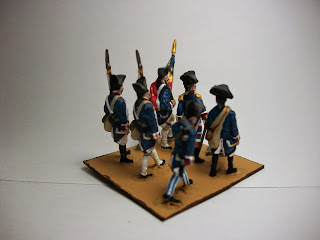I finished up another command stand today, this time for Slaughter's Kentucky Militia, which fought at the Battle of New Orleans. As such, the command stand features Lieutenant Colonel Gabriel Slaughter himself, who would go on to become the 7th Governor of Kentucky. (Remember to click on the pictures for bigger versions.)
The figures are 1/72 plastic and are mainly from the IMEX Lewis and Clark set, with the exception of the pointing guy with the fixed bayonet, who is a conversion from a figure from Italeri #6060. Uniforms are a mix and match of different homespun hunting shirts and leggings, with big floppy hats predominating, though LTC Slaughter himself is sporting a rather fetching coonskin cap.
I am originally from the great Commonwealth of Kentucky, and it's been nice to paint up a few of my fellows for the table. Kentucky contributed quite a few troops to the War of 1812; in fact, Kentucky as a state had more battle casualties during the war than all of the other states combined.
Slaughter's unit served well at New Orleans, and it was a member of his unit which was vividly remembered by an anonymous British officer when he wrote:
--------------------------
"We marched in solid column in a direct line, upon the American defenses. ...[W]hat attracted our attention most was the figure of a tall man standing on the breastworks dressed in linsey-woolsey, with buckskin leggins and a broad-brimmed hat that fell around his face almost concealing his features. He was standing in one of those picturesque graceful attitudes peculiar to those natural men dwelling in forests. The body rested on the left leg and swayed with a curved line upward. The right arm was extended, the hand grasping the rifle near the muzzle, the butt of which rested near the toe of his right foot. With his left hand he raised the rim of his hat from his eyes and seemed gazing intently on our advancing column. The cannon of the enemy had opened up on us and tore through our ranks with dreadful slaughter; but we continued to advance unwavering and cool, as if nothing threatened our program.
The roar of the cannon had no effect upon the figure before us; he seemed fixed and motionless as a statue. At last he moved, threw back his hat rim over the crown with his left hand, raised his rifle and took aim at our group. At whom had he leveled his piece? But the distance was so great that we looked at each other and smiled. We saw the rifle flash and very rightly conjectured that his aim was in the direction of our party. My right hand companion, as noble a fellow as ever rode at the head of a regiment, fell from his saddle. The hunter paused a few moments without moving the gun from his shoulder. Then he reloaded and resumed his former attitude. Throwing the hat rim over his eyes and again holding it up with the left hand, he fixed his piercing gaze upon us, as if hunting out another victim. Once more, the hat rim was thrown back, and the gun raised to his shoulder. This time we did not smile, but cast our glances at each other, to see which of us must die. When again the rifle flashed another of our party dropped to the earth. There was something most awful in this marching to certain death. The cannon and thousands of musket balls played upon our ranks, we cared not for; for there was a chance of escaping them. Most of us had walked as coolly upon batteries more destructive, without quailing, but to know that every time that rifle was leveled toward us, and its bullet sprang from the barrel, one of us must surely fall; to see it rest, motionless as if poised on a rack, and know, when the hammer came down, that the messenger of death drove unerringly to its goal, to know this, and still march on, was awful.
I could see nothing but the tall figure standing on the breastworks; he seemed to grow, phantom-like, higher and higher, assuming through the smoke the supernatural appearance of some great spirit of death. Again did he reload and discharge and reload and discharge his rifle with the same unfailing aim, and the same unfailing result; and it was with indescribable pleasure that I beheld, as we marched [towards] the American lines, the sulphorous clouds gathering around us, and shutting that spectral hunter from our gaze.
We lost the battle, and to my mind, that Kentucky Rifleman contributed more to our defeat than anything else; for which he remained to our sight, our attention was drawn from our duties. And when at last, we became enshrouded in the smoke, the work was completed, we were in utter confusion and unable, in the extremity, to restore order sufficient to make any successful attack. The battle was lost."
------------------------
Makes me kind of proud to be a Kentuckian.
I've only put five figures on this base to represent them as a militia unit and not a regular unit. As with the command stand for the 3/54eme, these guys have a painted but unflocked base. I will flock them as soon as I can get some Elmer's glue, more than likely after move later next week. The stand also features a conversion in order to utilize one of the armless AWI figures that I mentioned a couple of posts back: just a simple arm swap.
 |
| The two figures I used; I sliced the musket away from the kneeling Frenchman and glued it to the AWI militiaman without a right hand. |
















